Nash "METROPOLITAN" Build
***
 Shown below is an example of
Shown below is an example of
how we designed and constructed
a Nash Metropolitan chassis
sporting a new GM V6/305hp
modular motor. We designed and
mandrel bent the frame out of
2x4x11ga steel tubing using
our "No wrinkle" technology.
There are many challenges
in building one of these chassis,
dealing with the low fender openings
in the front, the wide modular
motor, and with the very narrow
track width. Maybe ideas can
be gained to help you with
your next complicated project.
*ON THE FIXTURE TABLE*
***
The chassis was built in
our prototype chassis table
area. As you will
see...Auto Weld
quality is throughout. At
this point the frame is
almost completely designed and
underway. It sports an Old style
9" Ford rear, tubular a-arms, Aldan
coilovers, our "Low Profile"
4-link, dropped spindles, and
will have a power rack and
pinion steering.
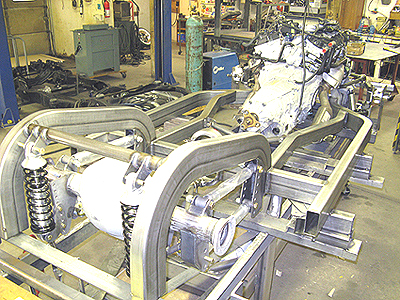 Note: To start a project like this,
Note: To start a project like this,
we first set and locate the
motor and trans on the chassis jig.
We then locate the spindles at the right
location and position, after that
...we are then ready to design
the rest the frame and suspension.
 Shown below: note how the
Shown below: note how the
upper contol arms wrap
round the motor to get
the needed front suspension
geometry.
***
NOTE: Modular motors are
wide at the oil pan area as
opposed to a conventional V6
or V8 which would provide
more a-arm room.
 Because this is a convertible,
Because this is a convertible,
the chassis has to be very rigid.
Shown are the crossmembers and
reinforcements.
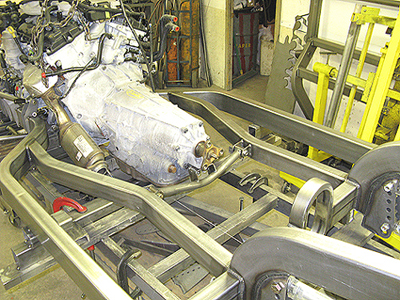 Below: This picture shows just how
Below: This picture shows just how
involved the front suspension was
to build. The custom bracketry
for the coilovers and the
special a-arms are just tacked
into place for now. Finish
welding will come later.
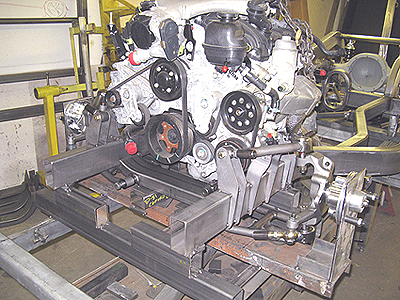 Our "Low Profile" 4-link was the
Our "Low Profile" 4-link was the
perfect candidate for this project
along with our shorter "Anglia"
length links. It has lots of
adjustment holes for instant
center changes.
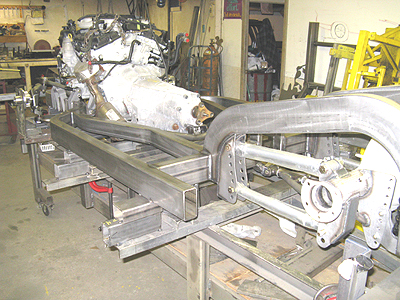 Close-up of the front suspension.
Close-up of the front suspension.
***
The a-arms are fully adjustable
and polyurethane bushed. "Aldan"
coilovers, Mustang II dropped
spindles and Wilwood hubs are
also shown.
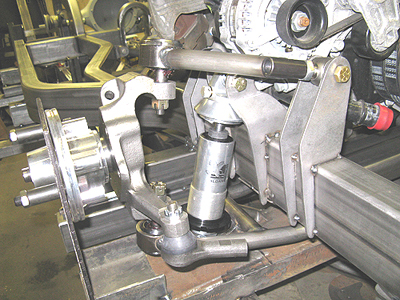 Below: Note how the frame rails
Below: Note how the frame rails
wrap around the front of
the chassis. Things to keep
in mind are: tire turn, catalytic
converter clearance, a-arm and
coilover position.
 OFF THE FIXTURE TABLE
***
OFF THE FIXTURE TABLE
***
Completed...well almost!
Notice that the outer
frame rails are designed to
run along the rocker panel.
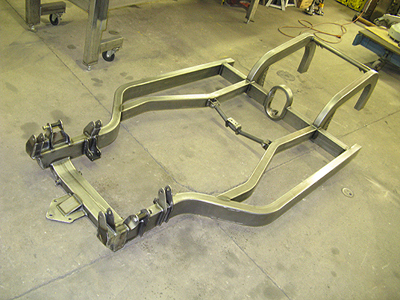 Looks simple now but was very
Looks simple now but was very
complicated to design. Note
the a-arm, coilover, motor and
trans mounts, and the triangulated
rack and pinion mount attached
to the front crossmember.
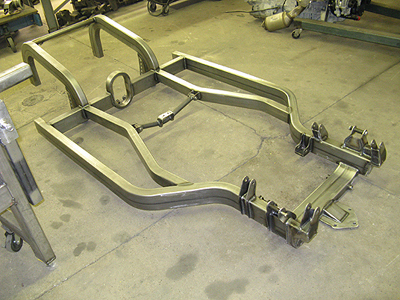 Shown from the rear are the smooth
Shown from the rear are the smooth
mandrel bent rails, oval driveshaft
loop, 4-link, and coilover
mounts...very sturdy.
 A well designed chassis makes
A well designed chassis makes
for a high-dollar car when
completed. "AUTO WELD" quality
is seen thoughout. True art!
 Below: Starting to take shape!
Below: Starting to take shape!
Note the "wishbone" track
locator.
***
Why a wishbone? It doesn't
deflect like a "Panhard bar".
Especially good on a short
narrow car.
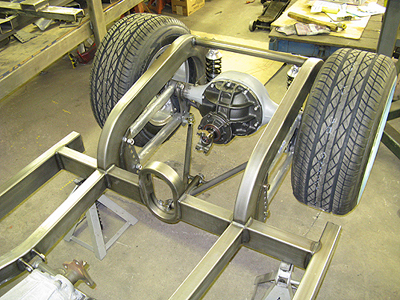 From the back: The tires
From the back: The tires
are not real big, but will
look big under the body.
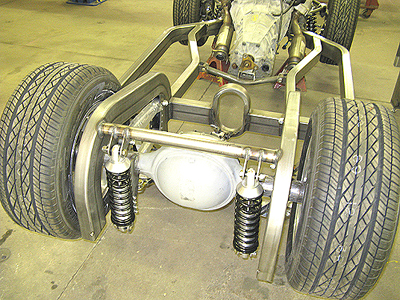 Note: Now dressed out...this is
Note: Now dressed out...this is
an example of just how crowded it
can get. "Woodward Co." is the only
company we could find that makes
"power" rack & pinions with a
ball width narrow enough
for this build. We got it to
work out while maintaining
zero bumpsteer to boot!
***
WOODWARD racks have an external
power slave and the servo is
on the steering shaft. The servo
can be rotated for clearance.
These are ideal for complicated
builds.
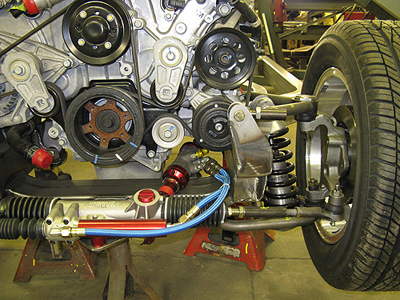 Full view: Good geometry is
Full view: Good geometry is
built in...positive caster,
anti-dive, zero bumpsteer....
all the good AUTO WELD stuff.
 Position of the motor and
Position of the motor and
trans will help with
the balance of this
short car.
 Below: a very
Below: a very
nice platform for
our Metropolitan
project. A true
hot rod!
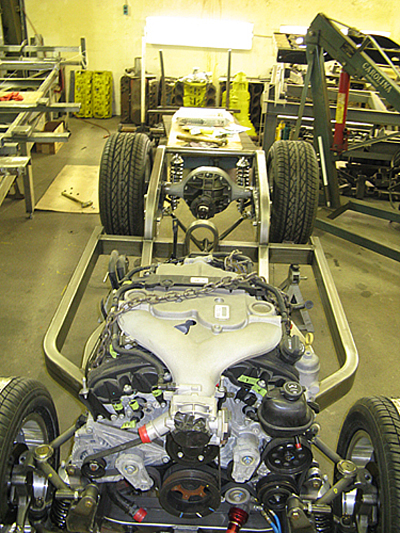 BODY FIT
This is how we install the body
BODY FIT
This is how we install the body
shell onto the new frame.
The floor-pan has been dropped out,
trimmed and cleaned. Fortunately
this body is very solid. No
structural rebuilding was required.
Note: The inner rocker panel has
been removed.
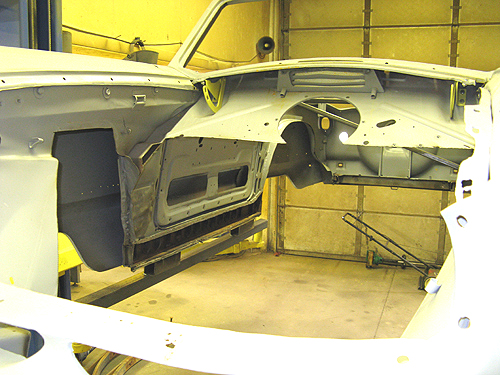 To keep the body from moving
To keep the body from moving
out of shape, we always
weld supports across the inside
of the body shell in several key
areas as shown. This is done
BEFORE the floor-pan is removed.
Also notice the supports
attached to the bottoms
of the rocker boxes that
are then held to the lift.
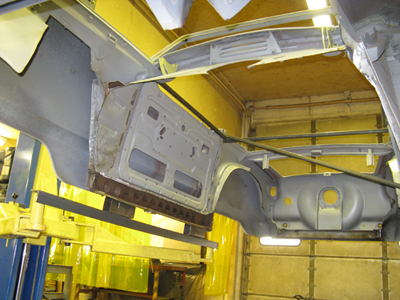 Since the new frame will run
Since the new frame will run
along the rocker panels, a
support with an added lip was
welded into position. This not
only adds strength, but the
lip makes it very easy to
align the body.
***
Below: C-Clamps are used to hold
body into position.

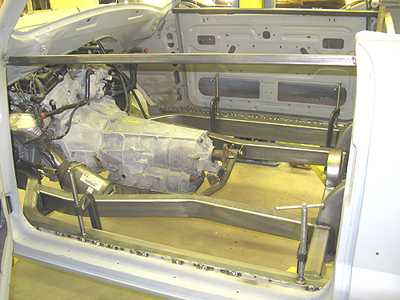 Body is now located and centered.
Body is now located and centered.
Note: The 1x1 reinforcements will
stay in until the the body
is permanently mounted.
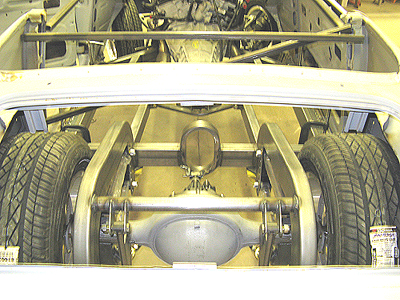 One thing to keep in mind when
One thing to keep in mind when
building a chassis like this
is the clearance for when the
tires turn.
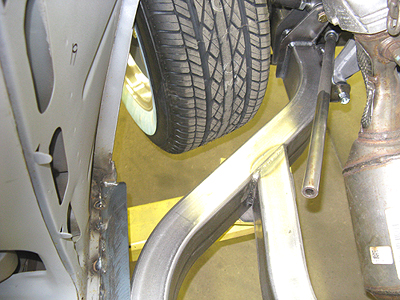 The steering shaft clearance is
The steering shaft clearance is
tight, but adequate.
***
Note: a strut rod stands
in place of the coilover
shocks at this time.
 We used the OEM driveshaft,
We used the OEM driveshaft,
but both halves had to be
shortened.
Note: The carrier bearing was
mounted to the oval crossmember.
The hole unit looks factory
and worked out perfectly.
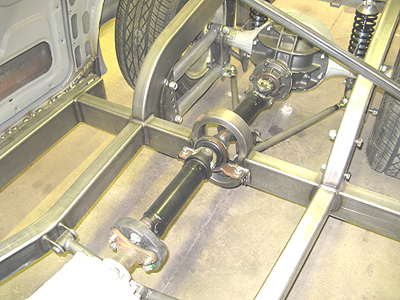 BELOW: Even though the motor has a
BELOW: Even though the motor has a
setback, and the firewall will have to
be custom made, it will still provide
adequate leg room.
 Note how this well designed frame
Note how this well designed frame
wraps around the catalytic
converters and also allows
for the tires to turn.
Also note the "smooth" bends
of the frame rails.
 This is as close as it gets. Sometimes
This is as close as it gets. Sometimes
you have to engineer something that can't
be done. Fortunately nothing had to
be stripped off the motor.
Shown below are the coilovers,
and a-arm locations and how they wrap
around the motor accessories. This
had to be done to get enough a-arm
length for the suspension to
work properly.
***
First picture...Passenger side
Second picture...Driver side

 Below: Engine bay closure will be
Below: Engine bay closure will be
fairly simple. Looks like the GM V6
belongs there.
 BELOW TWO PICTURES: 2x3 tubing
BELOW TWO PICTURES: 2x3 tubing
was extended from the
new chassis forward to the body
frame stubs to complete the unibody
structure.
The same was done in
the back car to attach the rear
of the body to the new chassis.
The frame was then finish welded.
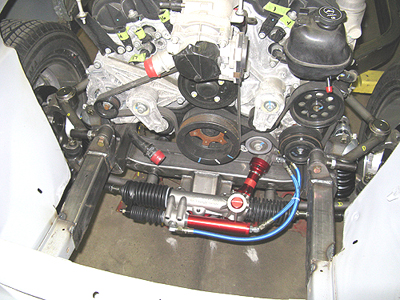
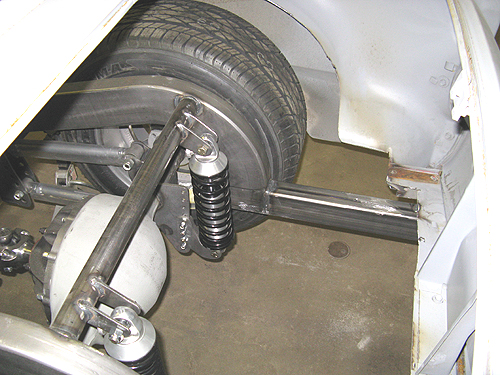 BELOW: Hood clearance is fine.
BELOW: Hood clearance is fine.
A good rule of thumb would be
....if you can slide your hand
between the top of the motor
and the hood....your safe.
Fortunately this motor was
the right height
for this build.
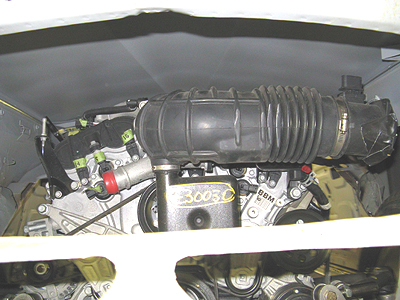 BELOW: Even though the body
BELOW: Even though the body
is not very tall...we were
still able to have good
ground clearance and have
a low center of gravity.
***
NOTE: never run an oil pan
less than 4" off the ground,
at "ride height", on a
street car!!!
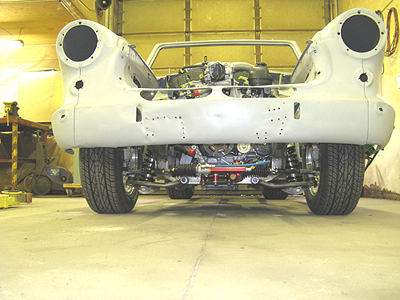 BELOW: Even though "low cut"
BELOW: Even though "low cut"
front fender openings and
tire clearance are a problem
with these cars...there is
still adequate turning angle.
 Tires are a good match for
Tires are a good match for
this car.
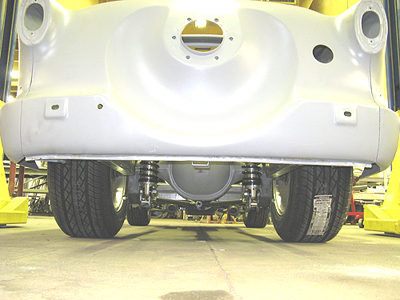 Whitewall tires up in
Whitewall tires up in
the fenders....
LOOKS AWESOME!!
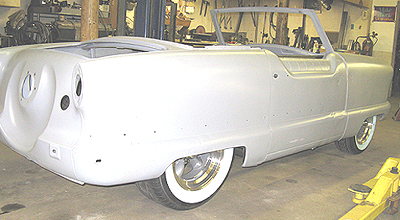
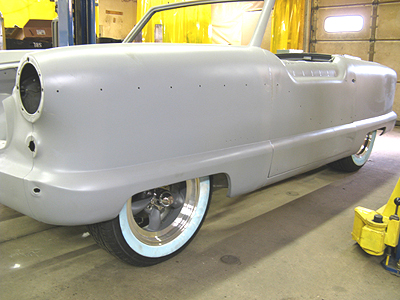 Considering that you can just about
Considering that you can just about
touch all four corners of the car
with your hand without getting
out of the seat...(not really!)...
the build came out very nice.
***
As you can see....at
AUTO WELD....we always
concentrate on quality first.
***
Maybe you can glean some ideas
from what we had to accomplish
on this tight little car.
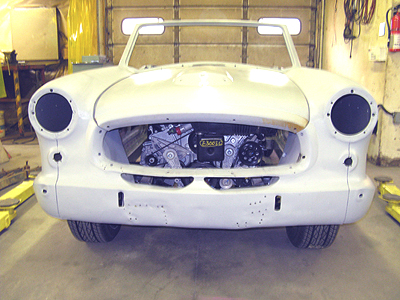
 VERY COOL!!
VERY COOL!!
|